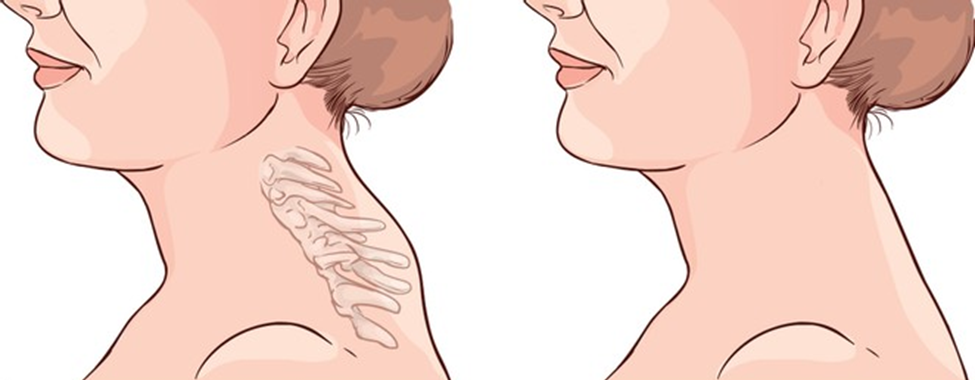Last updated on September 11th, 2023 at 06:28 pm
Buffalo Hump: Causes, Management, and Prevention
The buffalo hump, medically known as the dorsocervical fat pad, is a distinctive lump that can develop at the base of the neck and upper back. This condition often raises concerns and prompts individuals to seek insight into its causes, symptoms, and potential management. In this article, we delve into the world of the buffalo hump, shedding light on the factors contributing to its development, its implications for health, and strategies for prevention and management.

Symptoms and Causes:
A buffalo hump is characterized by the noticeable accumulation of fat in the upper back and neck region. While it can vary in size and appearance, its presence can be unsettling, leading to discomfort and self-consciousness. Several factors can contribute to the development of a buffalo hump, with one of the primary causes being Cushing’s syndrome—a condition characterized by excessive production of cortisol, commonly referred to as the stress hormone.
Understanding Cushing’s Syndrome:
Cushing’s syndrome plays a significant role in the formation of a buffalo hump. When the body produces an excess of cortisol, the delicate balance of hormones is disrupted. This excess cortisol triggers the storage of fat in specific areas, such as the upper back and neck. It’s important to recognize that Cushing’s syndrome can stem from various sources, including the long-term use of corticosteroid medications and certain health conditions.
Implications for Health:
The presence of a buffalo hump not only impacts physical appearance but can also have potential health implications. The excess fat accumulation in this area may lead to discomfort, particularly if the hump is large. Additionally, the development of a buffalo hump may serve as a visible indicator of an underlying hormonal imbalance or medical condition, prompting the need for further medical evaluation.
Diagnosis and Medical Evaluation:
If you notice the formation of a buffalo hump, seeking medical evaluation is crucial. Your healthcare provider will perform a comprehensive assessment, including reviewing your medical history, conducting a physical examination, and possibly ordering laboratory tests. These steps are essential to determine the underlying cause of the hump and to rule out any other potential health concerns.
Treatment Options:
The approach to managing a buffalo hump depends on the underlying cause. For individuals dealing with obesity-related buffalo hump, lifestyle changes play a key role. Maintaining a healthy weight through a balanced diet and regular exercise can contribute to reducing the size of the hump. If the hump is due to Cushing’s syndrome, addressing the underlying condition through medical interventions may be necessary.
Medical Interventions:
In cases where the buffalo hump is causing significant discomfort or is a result of an underlying medical condition, medical interventions may be considered. For instance, surgical removal of the fat pad can be an option to improve both physical comfort and appearance. Addressing the root cause, such as managing cortisol levels in the case of Cushing’s syndrome, is also vital to prevent further fat accumulation.
Prevention and Lifestyle Tips:
Preventing the development or worsening of a buffalo hump involves adopting a holistic approach. Lifestyle choices that support hormonal balance, such as managing stress levels and getting adequate sleep, can contribute to preventing excessive cortisol production. Regular physical activity, along with a diet rich in whole foods, can help maintain a healthy weight and reduce the risk of fat accumulation.
Seeking Professional Guidance:
It’s important to emphasize that self-diagnosis or self-treatment for a buffalo hump is not advisable. Consultation with a medical professional, such as an endocrinologist or a healthcare provider with expertise in hormonal imbalances, is essential for accurate diagnosis and personalized treatment recommendations.
Frequently Asked Questions (FAQs) About Buffalo Hump
Q: What is a buffalo hump?
A: A buffalo hump is a noticeable lump of fat that can develop at the base of the neck and upper back.
Q: What causes a buffalo hump?
A: It can be caused by factors such as Cushing’s syndrome, obesity, and long-term use of certain medications.
Q: What is Cushing’s syndrome?
A: Cushing’s syndrome is a condition characterized by excessive production of cortisol, leading to various symptoms including fat accumulation.
Q: What are the symptoms of a buffalo hump?
A: Symptoms include a visible lump at the upper back and neck, discomfort, and potential self-esteem issues.
Q: Can a buffalo hump be a sign of an underlying condition?
A: Yes, it can be an indicator of conditions like hormonal imbalances or Cushing’s syndrome.
Q: How is a buffalo hump diagnosed?
A: Diagnosis involves medical history review, physical examination, and possibly laboratory tests to identify the underlying cause.
Q: Can a buffalo hump be treated?
A: Treatment options vary based on the cause. Lifestyle changes, medical interventions, and addressing underlying conditions are possible approaches.
Q: Is surgical removal an option for a buffalo hump?
A: In some cases, surgical removal of the fat pad may be considered to improve comfort and appearance.
Q: Can lifestyle changes prevent a buffalo hump?
A: Yes, adopting a healthy lifestyle with balanced diet, regular exercise, stress management, and adequate sleep can help prevent fat accumulation.
Q: When should I seek medical help for a buffalo hump?
A: If you notice the development of a buffalo hump, it’s advisable to consult a healthcare professional for accurate diagnosis and guidance.
Conclusion
Understanding the buffalo hump and its potential implications empowers individuals to take proactive steps toward their health and well-being. Whether caused by Cushing’s syndrome, obesity, or other factors, a buffalo hump serves as a signal that warrants attention and medical evaluation.




